The Top Travel E-Commerce Websites in 2021
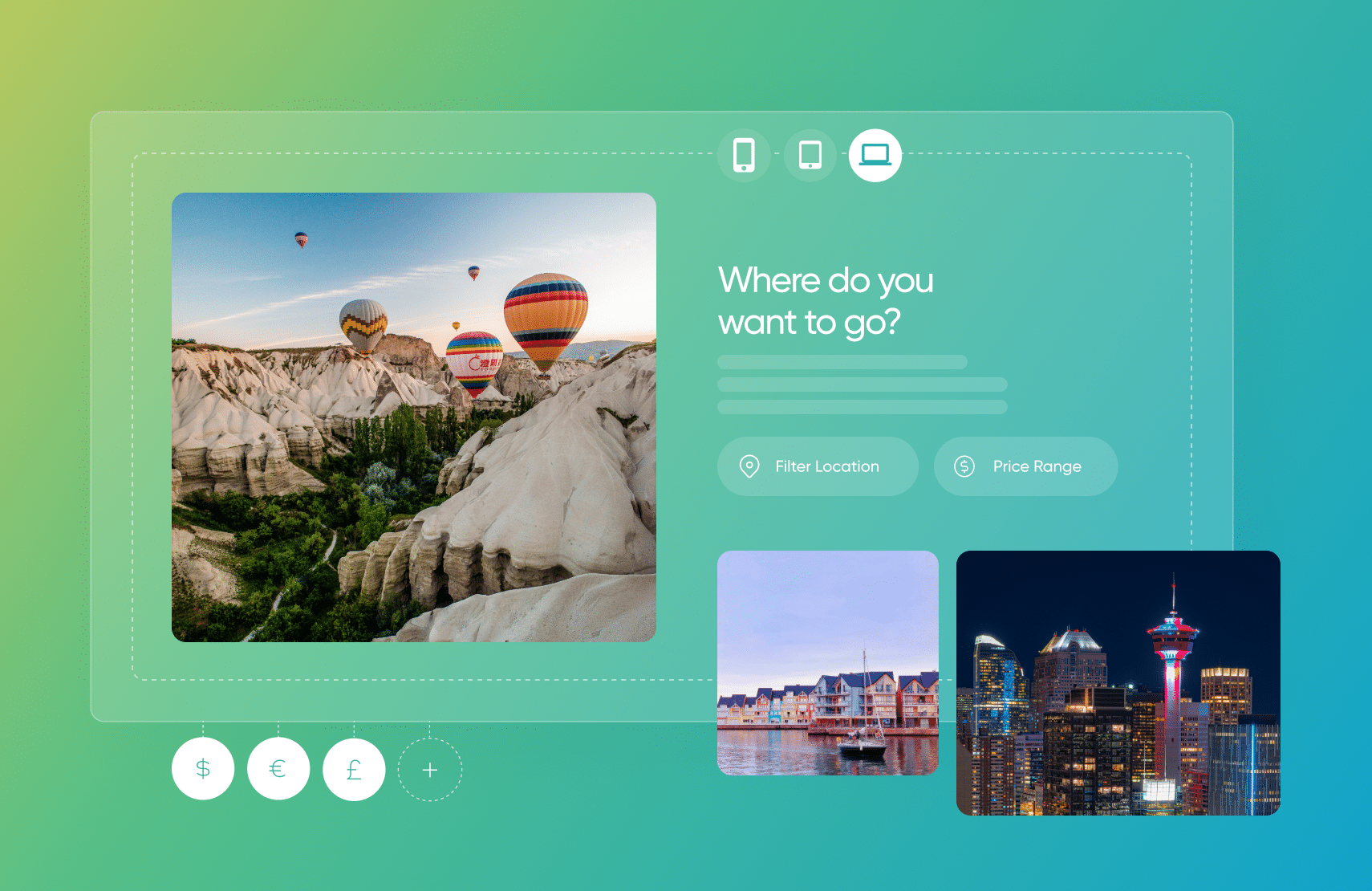
Top e-commerce travel websites leverage a headless CMS and e-commerce microservices to respond directly to their customers.
The travel industry popularized the importance and benefits of customer convenience, loyalty and rewards programs, competitive pricing and price comparisons, diverse search filtering, and streamlined checkout experiences.
The best travel e-commerce websites include Booking.com, Tripadvisor, Uber, and Airbnb, each of which uses an internally designed headless and modular architecture.
Licensing fabric allows travel e-commerce websites to reduce development overhead without negatively impacting the customer experience.
E-commerce changed the way travel providers and online travel agencies (OTAs) served consumers. The 1960s launch of SABRE, the world’s first computerized airline reservation system, led to the 1996 release of travel e-commerce website Travelocity.
Today, online sales and travel e-commerce websites contribute to 66% of the revenue brought in by the global travel and tourism market. Altogether, the global market size of e-commerce travel exceeds $517.8 billion.
Headless commerce allows travel e-commerce websites to continually innovate and respond to customers’ changing needs, especially as the industry responds to the COVID-19 pandemic. By using headless CMS solutions, the best travel e-commerce websites may continue to iterate, innovate, and grow their market share.
[toc-embed headline=”Features of Travel E‑Commerce Websites”]
Features of Travel E‑Commerce Websites
The travel industry popularized many of the features so common across e-commerce websites. Let’s look at some of the typical features you’ve come to expect from the best travel e-commerce websites.
A summary of common features leveraged by the best e-commerce travel websites is illustrated in the table below.
| Feature | How it’s used |
| Customer convenience | Helps customers search for and finalize every aspect of their travel itinerary from one single source. |
| Loyalty incentives and rewards programs | Frequent flier programs and discounts from partners incentivize repeat business and increased sales. |
| Competitive pricing | Dynamic pricing and personalization allow travel e-commerce sites to answer customers’ specific needs and price shop for the best rates and fares. |
| Search filtering | Versatile search functionalities respond immediately to the changing market to assist customers with making informed final decisions. |
| Simplified checkout | A quick checkout that doesn’t require registration and limits available offers to the most relevant helps reduce cart abandonment. |
Customer convenience
How did consumers book tickets, airfare, or accommodations before the internet? Travel arrangements required extensive planning via phone or in-person meetings. Without the assistance of travel agencies, consumers were required to coordinate plans with multiple points of contact — cabs or rental cars, airlines, and hotels.
E-commerce travel websites simplify this process. Instead of painstakingly coordinating an itinerary between multiple sources, consumers may plan, price shop, and purchase fares and lodging from or through one specific vendor.
Loyalty programs and incentives
Frequent flier programs are believed to have been introduced by Texas International Airlines in 1979 before being embraced further by American and United Airlines in 1981. In 2017, 91% of OTAs maintained a loyalty program.
Travel e-commerce websites use data analytics and insights to personalize offerings from intricate partner networks. Customers who participate in these programs earn anything from free or discounted fares, special rates on rentals and accommodations, and even discounted liquor, flowers, or health insurance.
Competitive pricing
Around the time travel e-commerce websites began to take off, airlines realized unsold seats could be sold at discounted rates by consolidators and auction houses. This appealed to flexible customers who preferred low fares over minimizing flight times and layovers.
Some e-commerce travel companies eventually adopted dynamic pricing to automatically adjust the cost of fares, lodging, and reservations. Leveraging personalization allows travel sites to “be more competitive” and respond to real-time market conditions while offering customers the ability to search for and choose offers that fit their budgets and needs.
Search filtering
Planning for travel is highly personal — no two customers’ journeys are the same. Travel e-commerce websites provide customizable search filtering designed to provide real-time information based on a customer’s requests, preferences, and needs.
Some companies, like Kayak, go the extra mile by providing charts to compare median prices based on historical data, destination, and travel dates. Responsive and useful search filters allow customers to easily find the results they’re looking for when planning their travel itinerary, guiding them further along the sales funnel.
Simplified checkout
Airline and travel e-commerce websites have some of the highest cart abandonment rates in e-commerce, at 87.87% and 81.31%, respectively. (For comparison, the average cart abandonment rate of online stores is 69.8%.)
OTAs and travel companies understand that cart abandonment stems from inefficient user interfaces and too much choice. By keeping the checkout process simple and limiting choices to the best offers, e-commerce travel websites may improve conversions and reduce abandonment.
[toc-embed headline=”Top Travel E-Commerce Websites”]
Top Travel E-Commerce Websites
E-commerce travel websites excel at using headless commerce to prioritize the customer experience. The top four travel and tourism companies ranked by traffic, as of August 1, 2021, are listed below.
Booking.com
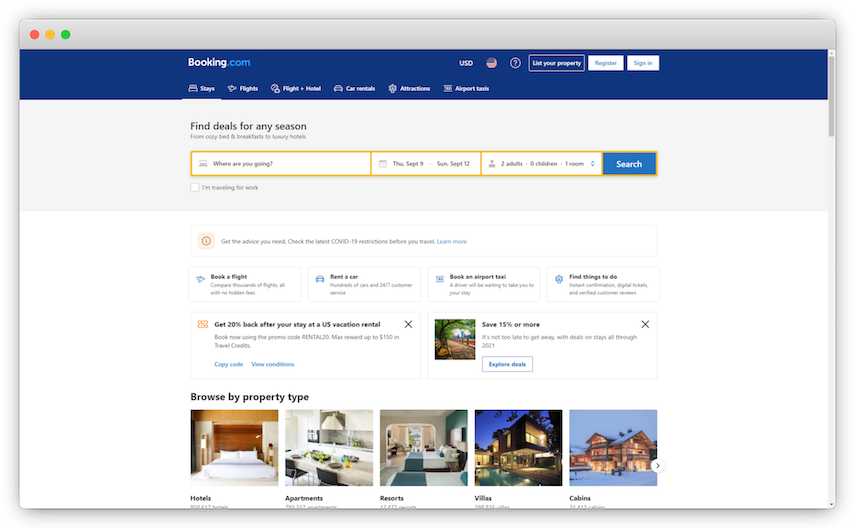
The home page of Booking.com, spotlighting its upfront search feature and options to make a wide variety of reservations.
- Customer convenience: Customers may book and reserve a variety of travel arrangements
- Loyalty programs and incentives: Yes, the Booking.com Genius program provides free lifetime access to discounts and rewards
- Competitive pricing: Guarantees the best available rates
- Search filtering: Extensive search filters for a wide variety of reservations
- Simplified checkout: No registration of prepayment is required; immediate confirmation
Since its launch in 1996, OTA Booking.com has continually iterated on its architecture and design to facilitate a convenient customer experience. Website visitors are immediately presented with a search box that recommends popular nearby attractions and distinctly highlights selected travel dates.
Site navigation is simple, too. Booking.com offers customers the option to book accommodations, flights, and car rentals, as well as tickets to attractions or and taxi reservations.
Reservations are instantly confirmed and free of booking and administrative fees. In many cases, Booking.com claims reservations may be canceled free of charge. The travel e-commerce giant also offers price-matching and guarantees the best available rates.
Booking.com is powered by an internally developed CMS. Though Booking.com’s internal architecture allows for scalability, its downside — especially when compared to headless CMS’s like fabric XM — is that developers must continually maintain the software and custom-build additions to the framework.
Tripadvisor
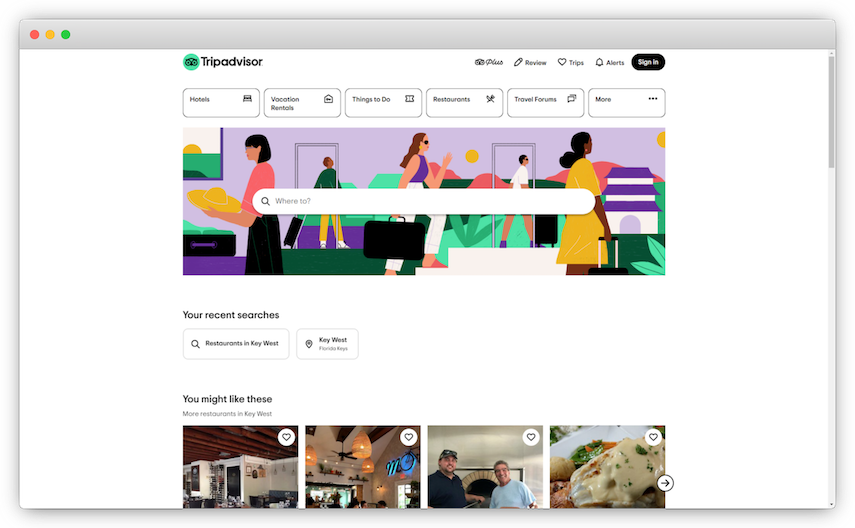
The Tripadvisor home page, with easy access to travel research and bookings and suggestions for local attractions and “experiences.”
- Customer convenience: Customers may quickly find, research, and book a wide variety of travel experiences
- Loyalty programs and incentives: Yes, for an annual feed, Tripadvisor Plus offers deals on hotel reservations and discounts on attractions
- Competitive pricing: Compares average rates from a wide variety of OTAs and booking websites
- Search filtering: Specific filters for each type of accommodation being researched and booked
- Simplified checkout: The checkout process is dependent on the specific partner site chosen
Tripadvisor, which bills itself as “the world’s largest travel guidance platform,” aims to help customers plan for and book travel arrangements. Eighty percent of Tripadvisor visitors take longer than four weeks to complete their purchase and spend 29% longer performing research than visitors to other sites.
Though Tripadvisor claims it is a “booking supplier” vs. OTA, customers may book hotels, vacation rentals, flights, rental cars, cruises, and even restaurant reservations. However, Tripadvisor emphasizes its user-generated “934 million reviews and opinions of nearly 8 million businesses over the sole ability to book travel arrangements.
In comparison to other travel e-commerce websites, Tripadvisor is structured to encourage travel “experiences.” Through a combination of research and suggestions, customers receive guidance intended to maximize their travel journeys.
The Tripadvisor website operates through a combination of microservices, achieving a modular and event-driven commerce architecture. . However, unlike with third-party e-commerce microservices that scale on their own, engineers must put effort into mitigating “cross-team overhead.”
Uber
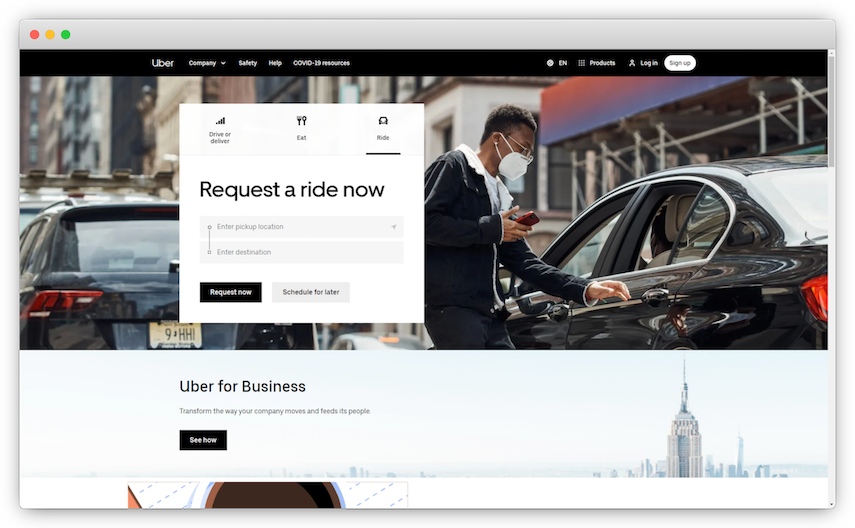
The Uber homepage offers access to the ride request form front-and-center, with the ability to request an immediate pickup or schedule one for a later time.
- Customer convenience: Quick and simple ride request/scheduling with a visible breakdown of the total estimated fare
- Loyalty programs and incentives: Yes, Uber offers the free-to-join Uber Rewards program, which rewards customers with points for booking rides or ordering food via Uber Eats; points may be exchanged for a variety of perks and benefits
- Competitive pricing: Provides nice estimates, but no comparison
- Search filtering: Serves over 10,000 cities and 600 airports globally, but rides aren’t always available on-demand
- Simplified checkout: Requires sign-up before requesting rides
Uber was founded in 2009 as a global ridesharing company that disrupted the taxi market. Since its founding, the travel e-commerce company has grown to be the world’s largest ridesharing company with 1.51 billion trips in Q2 2021.
After creating or logging into an account, riders may request a ride through the Uber website or its smartphone app. Customers may either request an immediate pickup or schedule one for later though, notably, service isn’t always available depending on the user’s location and the requested pickup time.
Uber’s travel e-commerce website is powered by multiple microservices. This headless and modular architecture allows Uber to develop independent services in different languages, depending on the need, while still integrating those microservices into the larger overall platform.
With this setup, Uber can continually integrate and improve its architecture to best meet the needs of its drivers and riders.
Airbnb
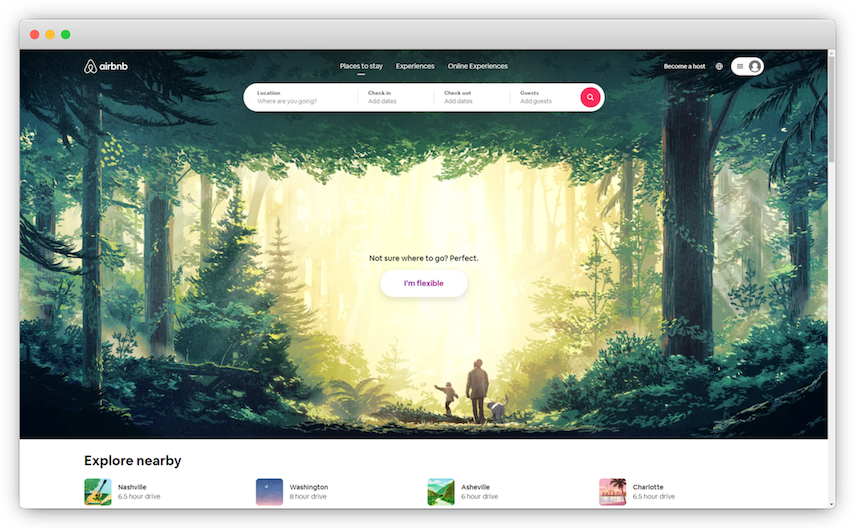
The main Airbnb page, with an accessible and highly visible search tool to quickly and easily present available listings according to the required parameters.
- Customer convenience: Easy to search for, sort, and review for relevant listings
- Loyalty programs and incentives: No, the Airbnb Superguest program has long been talked about but has no set launch date
- Competitive pricing: Individual rates are determined by Airbnb hosts but may be more affordable compared to traditional lodgings
- Search filtering: A wide variety of filters allow customers to narrow down results based on needs and preferences
- Simplified checkout: Requires an account sign-up before making reservations
E-commerce travel giant Airbnb was founded in San Francisco in 2007. Since then, it has expanded to over 220 countries and 100,000 cities, earning hosts an annual average of $9,600.
Airbnb allows customers to search through offered stays and experiences. A versatile set of filters helps users narrow down their search to find accommodations that meet their specific requirements. Customers are also presented with reviews, ratings, and the cost of each offer. In addition, each offer displays specific details about the property, similar to typical real estate or apartment listings.
In 2017, Airbnb began transitioning to a service-oriented architecture built on a Thrift IDL-centered framework. As a result, Airbnb developers could prioritize resilience to improve and support server stability without compromising service quality.

Executive business partner @ fabric. Previously flight attendant @ Air Canada.

Tech advocate and writer @ fabric.